Country Report: Canada
"Science powers commerce," Canadian Prime Minister Stephen Harper remarked in 2010. In those three words, the Prime Minister summarizes a massive effort by various stakeholders to create a "brain gain" in Canada to strengthen its positioning in the world of research and technology. Despite declining investments by big pharma in recent years, the country has created a number of innovative ways to incentivize R&D and leverage its geographic reach in the North American Market.
This sponsored supplement was produced by Focus Reports.
Project Director: Chiraz Bensemmane
Editorial Coordinator: Cameron Rochette, Martijn Jimmink
Project Publisher: Ines Nandin, Julie Avena
Contribution: Ibtissam Sadouni, Omar Rahli
For exclusive interviews and more info, please log onto www.pharmaboardroom.com or write to contact@focusreports.net
CANADA: The Hidden Gem
"Science powers commerce," Canadian Prime Minister Stephen Harper remarked in 2010. In those three words, the prime minister summarizes a massive effort by various stakeholders to create a "brain gain" in Canada to strengthen its positioning in the world of research and technology. Despite declining investments by big pharma in recent years, the country has created a number of innovative ways to incentivize R&D throughout its vast geography.

Inuksuk by Dave Dyet - www.dyet.com
Chances are that Canada is not the first country that comes to mind when thinking of important pharmaceutical markets: dwarfed by its US neighbor, Canada, which has a population of 35 million, would seem to have a tiny market (USD 326.9 billion in the US versus USD 21.9 billion in Canada). Yet, according to IMS Health, the country has the seventh largest pharmaceutical market in the world.

Rémi Quirion, Chief Scientist of Quebec
As well as having one of the largest pharmaceutical sales market, Canada also has a thriving research community, a fact that is not widely known. "Canada has not been aggressive enough to sell itself," said Rémi Quirion, Chief Scientist of Quebec. "The world is small enough that if Canada does not promote itself, others will leave the country behind in the dust. Waiting for people to call us will not work." Perhaps Quirion's remarks are reflective of Canadians' tradition of politeness and modesty; however, the country is taking steps to make a name for itself in the research segment as well. "Canada has gone from an era of 'brain drain' in the early and mid-1990s to an era of 'brain gain', with some of the most brilliant researchers from around the world now being attracted to this country because of its commitment to research," says Gilles Patry, CEO of Canada Foundation for Innovation. "With 0.5 percent of the world population Canada produces 4.1 percent of the peer review journals around the world and five percent of the most highly cited papers. As we say, Canada is really punching above its weight." Now the challenge is spreading the word.
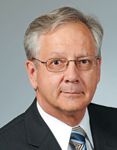
Gilles Patry, CEO of Canada Foundation for Innovation
Last year, Forbes Magazine rated Canada the number one country in the G20 for doing business, and according to the World Bank, Canada leads all G7 countries in average economic growth between 2002 and 2011. According to American magazine Entrepreneur, Toronto and Vancouver are currently ranked as the eighth and ninth best ecosystems for startups worldwide.

Sue Paish, CEO - LifeLabs
Since 2006, the federal government has invested over CAD 9 billion (USD 8.71 billion) into science, a rare feat compared to many other countries since the economic recession. As former Minister of State (Science and Technology) Gary Goodyear states, this investment has been "a significant turnaround fostered by an attitude that was completely contrary to what many other countries were doing to battle their debts and the economic downturn."

UNITY IN DIVERSITY
Canada is one of the world's most heterogeneous nations. Individuals from every corner of the planet have come here throughout the country's brief existence to live permanently. The ability to have a successful career and quality of life in Canada is second to none; the Economist Intelligence Unit ranked Vancouver, Toronto and Calgary as the third, fourth and fifth most livable cities worldwide in 2013. The country attracts immigrants worldwide to live and work; walking down Yonge Street in downtown Toronto, you're likely to hear at least a dozen different languages being spoken within a couple of blocks.

Gary Goodyear, former minister of state (science and technology)
The fact that Canada's unique demographics are spread across the second geographically largest country in the world has resulted in some adaptations. Medical services are therefore mostly concentrated in a few urban centers spread across massive expanses of land. Sue Paish, CEO of diagnostic service provider LifeLabs, comments that "community diagnostic labs are characterized by the need for high volume, exceptionally efficient, reliable and accessible delivery of lab services to geographies that in this country are significant and to other countries are unfathomable."

Réjean Hébert, Quebec's Minister of Health and Social Services
Home care is an excellent way to adapt to the challenges of a large geographical footprint, and so seems to be a good option for Canada, which currently spends the least in investing in long-term care out of developed countries. The OECD has indicated that prioritizing home care can result in savings of up to one percent of GDP. In Quebec, which has the second fastest ageing population in the world after Japan, that one percent could total CAD 3 billion (USD 2.9 billion). Quebec's Minister of Health and Social Services, Réjean Hébert, indicates that the implementation of autonomy insurance would help cut costs in the long run. "At the moment, disabled people have to move from one institution to another corresponding to their needs," Hébert explains. "Autonomy insurance will re-provide the right for disabled and the elderly to choose where they want to live and to get the services they need."

Jacques Dessureault, president, Valeant Canada (Crédit photo: Marc-André Grenier, collection de l’Assemblée nationale du Québec)
CANADIAN HEALTHCARE: PARALLELING EUROPE?
Canada operates a single-payer healthcare system in which the majority of services are provided by private entities, which are paid for at the provincial level. The Canada Health Act of 1984 stipulates universal coverage for all insured health services as administered by the country's ten provinces. Medication is covered on a province-by-province basis. The split between public and private healthcare is roughly 70 to 30 percent.

Christian Scheuer, president and CEO, LEO Pharma Canada
"Canada is perhaps the only developed market with an emerging market growth outlook," says Riad Sherif, president of Novartis Canada. "It is a mature and well-established market with strong processes in licensing, registration, reimbursement, and assessment of drugs. Yet it also has an emerging market growth outlook, which means a positive outlook expansion if you do the right things."

Deborah M.Brown, president of EMD Serono Canada
Because healthcare is managed by each of the ten provinces, pharmaceutical companies have to look at Canada as ten individual markets, as each has its own regulations regarding pricing and reimbursement. "Canada actually parallels Europe in terms of pricing, reimbursement and market access," remarks Michael Seckler, CEO of Ferring Canada. "The country has a challenging product launch environment and requires careful considerations to provincial and private payer reimbursement. We have to be cleverer to communicate our value proposition to payers and other stakeholders. We take this very seriously and at Ferring we start consideration of market access as early as possible in product development and life-cycle management planning."
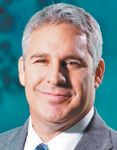
Michael Seckler, CEO of Ferring Canada
According to LEO Pharma Canada's president and CEO Christian Scheuer, the complexity of the Canadian system has created an opportunity for some pharma companies to reinvent their business model. "There are so many stakeholders to engage with today that it creates a system or a network," says Scheuer. "From an internal organizational perspective, it would imply that access and scientific affairs are now as important as sales and marketing when engaging with the marketplace."

Brian Lewis, president and CEO, MEDEC
DRUGS: COST OR INVESTMENT?
Part of the challenges come from having an incredibly complex and multi-layered system. Deborah Brown, president of EMD Serono Canada, comments that "for such a vast geography with a population the size of California, to have 10 decision makers in healthcare makes no sense. We are duplicating costs over and over in the healthcare system." Brown also points to the inefficiency in monitoring prescriptions. "In terms of cost utilization efficiency, I think that adherence must be tackled, particularly with proper use of medications. Pharmaceutical companies in Canada need to determine if patients are actually taking their medications correctly or often enough, which would reduce costs. This populace perspective on the freeness of drugs can result in patients not being adamant about taking medications or having a poor diet. Because EMD Serono is in the specialist area, it is a unique challenge for us to offer value, particularly given the cost of many of the company's products."

Kevin Leshuk, vice-president and general manager of Celgene Inc
"Regarding the provision of public access and drug approval, Canada ranks 26 out of 32 developed countries," says Valeant Canada president Jacques Dessureault. "On average, only 20 percent of products get reimbursement. Clinical data repositories do not even provide a positive response to half of the brands seeking public reimbursement. It is a very tough environment to do business because of the opportunity of an ageing, socialized, and organized healthcare system combined with pressure on the system."

Claude Perron, General Manager of Shire Canada
Because health-related products are often considered a simple line-item in a provincial budget, "there is a tendency in procurement to only look at price," says Brian Lewis, CEO of MEDEC, Canada's national medical technology association. "A device might have a price that is higher for the operating room (OR) and when you are in a hospital the OR can only grow so much because budgets are cut into silos there. The downstream effect of the product is that re-hospitalization and retreatment are reduced because of the device's value but the amount that those considerations are accounted for when products are purchased is not enough."

Barry Fishman, president and CEO Teva Canada
RARE DISEASES: CANADA'S RARE CHALLENGE
One of the most evident examples of the difficulties of Canadian market access is seen with medications for rare diseases. Canada is the only country in the G8 that does not have a formalized orphan drug policy. There are about 200 medications available in Europe and the US that are currently out of reach for Canadians apart from a Special Access Program (SAP), which grants exceptions for quickly needed unapproved (and often expensive) drugs. Orphan drug companies, the majority of which are small, tend to think that because the price of patented orphan drugs are based on the median price of developed states in the EU, that Canada's prices are too high, despite having a population bigger than many European countries.
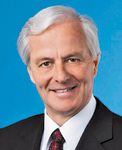
Russell Williams, president of Rx&D
Kevin Leshuk, vice-president and general manager of Celgene Inc., noted that advances in the formalization of a policy must be in tandem with funded formal access mechanisms to become a reality. "If Canada only improves the front end through R&D incentives or tax credits without focusing on the intellectual property and reimbursement components then we are not truly improving the future for patients living with rare diseases," comments Leshuk. "The lack of a formalized orphan drug designation in Canada highlights us as a laggard country compared to other countries where most if not all have some form of recognized orphan disease policy."

Paul Lucas, president of Life Sciences Ontario
Claude Perron, General Manager of Shire Canada, points out that "innovative medications need to be seen as what they are: an investment in our healthcare systems, not a cost. This integration of innovation into the healthcare system should lead to improved health outcomes and efficient use of resources." As such, Shire Canada has made substantial efforts to establish itself in the rare disease field, particularly in lysosomal storage diseases.
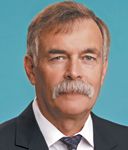
Jim Keon, president of Canadian Generic Pharmaceutical Association
GENERICS IN CANADA: CHALLENGE OR OPPORTUNITY?
Canada has enjoyed a strong generic industry for decades. The majority of generic drugs sold in Canada are also manufactured in Canada, with more than 95 percent of manufacturing and research for generics taking place in Ontario and Quebec, employing more than 14,000 Canadians. In 2012, 63.2 percent of all prescriptions in Canada were filled by generic pharmaceuticals, yet comprised only 24.4 percent of total drug expenditure (CAD 22.1 billion, or USD 21.38 billion). According to Teva Canada president and CEO Barry Fishman, "63.2 percent is too low and should become closer to the US level of approximately 80 percent. The Canadian generic industry and other key stakeholders are working to ensure appropriate levels of generic utilization."

Michael Brogan, president, IMS Brogan
"Both public and private payers encourage the use of generics when they are available, to ensure that healthcare dollars are allocated effectively," notes Fishman. "We have to get our message of 'same quality, better price' to encourage higher levels of generic usage in the Canadian healthcare system."

Has Canada’s generics public policy failed?
TURNING SCIENTISTS INTO SALESMEN
Canada has tremendous resources at its feet for research and innovation: the Canadian federal government has committed to over 500 new projects, buildings and laboratories in the last seven years. Life science is one of the most important sources of jobs and drivers of economic growth in Canada, along with aerospace and IT.
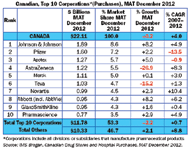
Canadian, Top 10 Corporations*(Purchases), MAT December 2012
Despite all this great research, Canada's unique problem appears to be its inability to connect business development and entrepreneurship with this great scientific capacity. So, how can Canada use its immense research infrastructure to turn locally produced science and technology into commercial success? This has partly been done through the restructuring of the National Research Council (NRC) in early 2013. John MacDougall, president of NRC, noted that despite research investment in Canada being in the middle of the OECD countries, innovation performance is in need of improvement. By placing a greater emphasis on commercial research, reaching a balance between basic and commercial research will allow for more effective commercialization of science produced in Canada. McDougall describes this process as "working from the market back, rather than from discovery forward, while balancing the innovation system more appropriately to extract more value from NRC's investment."

Is Canada’s intellectual property regime competitive?
A particularly innovative example of this push towards commercialization has been demonstrated through the collaborative efforts of 16 research institutions in Toronto. This resulted in the establishment of a centralized organization in 2007 called MaRS Innovation (MI), funded by the Canadian government and membership fees by each of the 16 institutions. Raphael Hofstein, president and CEO of MI, explains that MI's "sole charter is to improve on commercialization with a minimum of CAD 30 million (USD 29.03 million) for five years. Our 16 members in downtown Toronto generate significant intellectual property for the MI pipeline, which stands to transform Toronto's performance as a research commercialization hub within the larger Canadian scene." MI chooses the most promising of several hundred ideas with which it is presented every year to take to market, with the assistance of big pharma.

Raphael Hofstein, President and CEO of MI
Another way in which big pharma can continue maintaining R&D in Canada is through outsourcing. However, according to John Sampalis of local CRO JSS Medical Research, the industry for CROs in Canada is fragmented. "Canadian CROs conducting Phase II and III trials also face the challenges of globalization of the business, by which large pharmaceutical companies have forged relationships with large CROs. Regional affiliates are expected to work with those large CROs, therefore denting market availability for Canadian CROs," says Sampalis. "In the absence of business, smaller Canadian CROs cannot expand their service offering, and will stay small, become smaller or disappear. This affects the entire principle of why research is supported by the Canadian government, which is to provide work to local CROs and universities and promote that research activity and development in Canada."

John MacDougall, president of NRC
BRINGING IN THE BIG BUCKS
The biggest challenge for local biotech companies in Canada, as is the case in many countries worldwide, is access to capital. The number of venture capitalists investing in Canadian biotech has decreased significantly in recent years, and as much as by 60 percent in 2012 compared to 2011. Since the economic recession in 2008, VCs are generally much more risk-averse, since an unsuccessful investment could spell bad news for them. "There is a degree of risk-taking in terms of investment population; people must be prepared to fail with investments in drugs," comments Nick Green, president of Therapure BioPharma Inc. "You have to understand the market, be prepared to take risks, and be capable of analyzing opportunity as well as acting and managing investments."

Patrick J. Cashman, president and general manager - Lundbeck Canada Inc.
Fernand Labrie, CEO of local biotech company Endoceutics, notes that "there have been many attempts to facilitate and provide more funding. However, the way in which this funding has been processed has been far too diversified, spread thin across too many agencies, all of which need to exert independent judgment on the value of the submitted projects. There is too much division of a limited expertise. Funding is easier in the US, but the limited knowledge of venture capitalists regarding the scientific value of the projects and of the potential of the life sciences industry is also problematic."
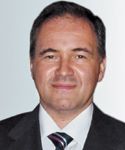
John Sampalis, CEO, JSS Medical Research
Andrew Casey, CEO of BIOTECanada, notes that the establishment of a competitive public policy framework will help to attract capital investment. "You need to find a way to reward investment in the industry in Canada," says Casey. "However that reward is structured, the industry would welcome it, since you are essentially putting out the welcome mat. Successfully growing a company in Canada will ultimately lead to the growth of new companies, which in turn grows the industry.
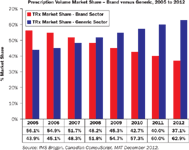
Tax credits, while often a common point of reference for biotech companies worldwide, play a vital role in the secretion of Canada's own biotech industry. According to Investissement Québec, the net cost of one Canadian dollar expenditure in an eligible research project in Quebec can be as low as 36 cents, resulting in savings of up to 64 percent.

Nick Green, president and CEO - Therapure Biopharma Inc
Furthermore, despite the downward trend of venture capitalists fuelling the pipeline of local biotech companies, a number of big pharmaceutical companies have made commitments to various funds throughout the country. Lilly established a CAD 150 million (USD 145.16 million) partnership fund with local fund of funds Teralys Capital, GSK committed CAD 50 million (USD 48.39 million) to establishing a Life Science Innovation Fund, and Merck Canada has invested CAD 40 million (USD 38.71 million) into a biosciences fund with local venture capitalist group Lumira Capital. These kinds of investments are perhaps indicative of a new pharma model in the making.

Fernand Labrie, CEO - Endoceutics
However, not everyone is inclined to agree with this model. As Youssef Bennani, site head and vice president of R&D at Vertex Canada, describes, "Companies in Canada are often built to be sold or partnered, and therefore have a finite timeframe with which to work, mostly driven by venture capitalists and investors. That unsustainable mechanism has to change; otherwise you will see no improvement in output." In order for this to happen, Benanni continues, "the Canadian pharmaceutical community needs to strategically revamp their investments, commitment and goals to create a sustainable pharmaceutical business the way Bombardier has done in the aeronautic space."

Andrew Casey, CEO of BIOTECanada
LOOKING FOR THE PHARMA BOMBARDIER
Many in the industry agree that the creation of a pharmaceutical version of Bombardier, which would promulgate greater economic activity in Canada, is unlikely to happen except through consolidation. "Biotech companies are being acquired more quickly as big pharma seeks to add products to their sales and development portfolios," remarks Tony Cruz, Chairman and CEO of Transition Therapeutics. Transition, which in-licenses drug candidates to advance from Phase I and proof of concept (POC) to Phase II trials, offers big pharma a unique solution. "Big pharmaceutical companies need to broaden their pipelines, which is becoming their biggest expense. Transition's model is an easy way to mitigate their risk by outsourcing the broadening of their pipeline. They can now make better decisions having POC data available on additional drug candidates to reduce risk in prioritizing programs for later stage development."

Mark Lievonen, president and CEO of Sanofi Pasteur Limited
Gail Garland, CEO of the Ontario Bioscience Innovation Organization (OBIO), states that "the development of procurement policies will encourage companies to stay and grow in Canada. Ontario companies are developed to become world exporters, but selling in Ontario and Canada will better contribute to their longevity here as Ontario-based companies." OBIO's Capital Access Advisory Program (CAAP) helps to develop and build the industry beyond seed-stage companies. In the field of medical devices, over 80 percent of locally made products are sold outside of Canada. "If the FDA approves a Canadian product, the producer will feel more comfortable selling that product in an American jurisdiction," remarks BD Canada's vice president and general manager North America Frank Florio. "Those integrated biases and long time relationships between multinational sales teams and doctors or administrators make it hard for a small local company to convince customers it has something more innovative that can deliver better value."

Tony Cruz, Chairman and CEO of Transition Therapeutics
Mark Lievonen, president of Sanofi Pasteur Canada, says that Canada's challenge is translating research into products and services that attract investment in Canadian companies. "Canada needs to enhance its biopharma ecosystem through a mixture of multinationals, strong biotech companies, and home-grown success stories that can compete in the global market," Lievonen explains. "If Canada could develop ten biopharma companies with significant R&D and manufacturing capacity, each generating CAD 1 billion (USD 970 million) per annum, then you start to build a critical mass of large scale companies that can support and contribute to the overall ecosystem."

Youssef Bennani, site head and vice president of R&D at Vertex Canada
Dr. Niclas Stiernholm, president and CEO of Stem Cell Therapeutics (SCT) acknowledges that there is great possibility for small biotech companies to become a division or a unit of a large pharmaceutical company. SCT is Canada's only public company dedicated to advancing cancer stem cell discoveries into novel and innovative cancer therapies. The company's focus on novel cancer stem cell therapies is further strengthened by the acquisition of Trillium in April 2013, a private biopharmaceutical company with a strong interest in cancer stem cells and immunology. Stiernholm, former CEO of Trillium, comments that Trillium was not going to sustain due to venture capital funds running out of patience, money and interest. "In order to continue its work, the best solution was to merge Trillium into a publicly traded company and raise money in the public market", he adds.

Quebecois creativity in innovation
FOCUS ON YOUR STRENGTHS
"Big pharma companies are not in the business of establishing huge research laboratories themselves," says Reza Moridi, Minister of Research and Innovation of Ontario. "They prefer to invest in VCs. Through them, big pharma invests in various smaller projects, universities, research hospitals and other research centers. We realized this in Ontario, and consequently created the Ontario Venture Capital Fund in 2008. This was a CAD 205 million (USD 198.38 million) fund, and attracted about CAD 750 million (USD 725.78 million) worth of investments from the public and private sector." The province of Quebec has also demonstrated its continual commitment to forging strong relationships between industry and academia. As Yves Bolduc, official opposition health critic of Quebec states, "Given Quebec's solid investment in research and infrastructure, particularly with universities, this will create attractive partnerships for pharmaceutical companies and ultimately be a strong driver of the province's economy. For example, Hôpital St-Luc is creating a new CAD 2.3 billion (USD 2.22 billion) research center for the University of Montreal, and will be the biggest in Canada. McGill University is also building a new research hospital valued at CAD 1.4 billion (USD 1.35 billion). Hôpital St-Justine has invested CAD 1 billion (USD 970 million) into modernizing its facilities."

Nicolas Marceau, Minister of Finance and the Economy - Province of Quebec
Canada has also invested greatly into personalized medicine and genomics. According to Roche Canada's president and CEO Ronnie Miller, "30 percent of GPs in British Columbia have already seen a patient who has had a genetic review to determine the best treatment. That is a major change in thinking, and the genetic mapping of all Canadians could create huge savings in healthcare costs." Roche Canada has therefore placed a great emphasis on personalized and precision medicine in its portfolio, and the federal government has invested billions of dollars for research at genomics institutes throughout the country, such as Genome Canada or the Ontario Genomics Institute.

Max Fehlmann, president and CEO - NEOMED
Many multinationals have demonstrated their commitment to Canada through a number of high profile investments in innovation funds and research centers. Roche has invested CAD 190 million (USD 183.86 million) in a global clinical development site in Mississauga, Ontario, one of six in the world, and also selected the Montreal Heart Institute as its global research hub for cardiometabolic diseases. In 2011, Merck invested CAD 33.2 million (USD 32.12 million) in modernizing and expanding its manufacturing facilities in the country. In 2010, Sanofi Pasteur invested CAD 101 million (USD 97.73 million) in a new R&D facility for vaccines.

Diane Gosselin, president and CEO - CQDM
BMS is another company to bet on Canada's potential. "BMS Canada is one of the organization's largest affiliates worldwide and one of the most active in clinical research. We have been a front-end research leader in Canada. We have invested CAD 50 million (USD 47.75 million) in 2012 alone into clinical trials, and we have 50 compounds in development so there is a lot of potential. BMS Canada has partnered with some of the leading academic institutes, such as the Institute for Research in Immunology and Cancer (IRIC) in Montreal", says Teresa Bitetti, general manager BMS in Canada. She concludes: "Canada has everything that is needed for strong R&D activity – an educated work force, a stable economy and global world-class leading academic institutions."

Riad Sherif, President of Novartis Canada

Gail Garland, CEO of the Ontario Bioscience Innovation Organization (OBIO)

Frank Florio, BD Canada's vice president and general manager North America
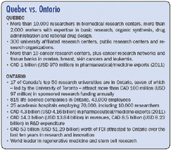
Quebec vs. Ontario

Niclas Stiernholm, President and CEO of Stem Cell Therapeutics (SCT)
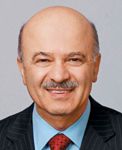
Reza Moridi, Minister of Research and Innovation of Ontario

Ronnie Miller, president and CEO, Roche Canada
"Imagination is more important than knowledge."
–Albert Einstein
The Canadian life sciences ecosystem has all the right parts in place to become one of the most attractive hubs in the world. The country's exceptional infrastructure, emphasis on research and science, immense talent pool, and highly regarded education system all play a role. Ultimately, it is up to all stakeholders involved to ensure that these various dots are connected and packaged in a way that shows their value.
